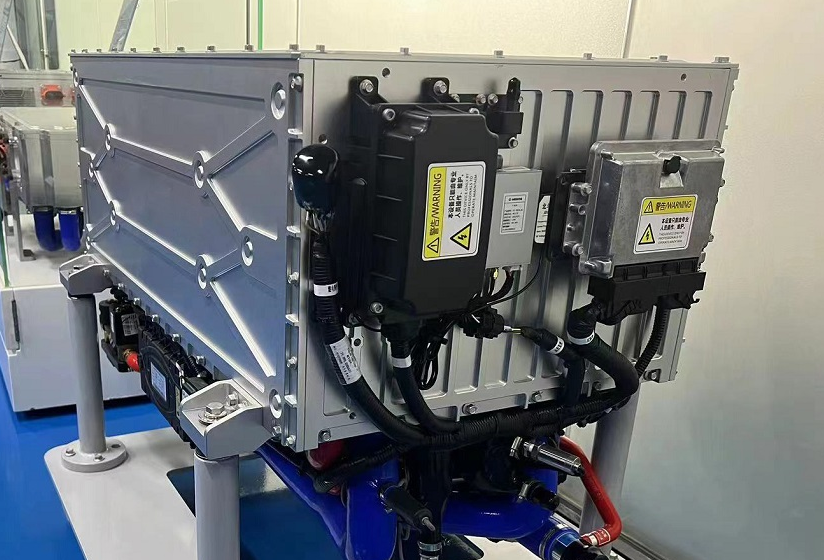
A 燃料電池エンジン 水素を化学反応で電力に変える画期的なクリーンエネルギー技術です。 このプロセスは、有害排出を排除し、副産物として水蒸気と熱だけを生成します。 高効率とゼロのテールパイプ汚染物質を提供することで、燃料電池エンジンは重要な気候課題に対処します。 温室効果ガス排出量削減と持続可能なエネルギーソリューションの推進に重要な役割を果たしています。 さらに、高度なコンポーネントの統合など 燃料電池 MEA (Membraneの電極アセンブリ)は、この技術に従来の燃焼エンジンに有望な代わりを作る最適の性能を保障します.
要点
- 燃料電池エンジンは、水素をゼロの有害排出物で電力に変換し、従来の燃焼エンジンにクリーンな代替手段を提供します.
- 燃料電池エンジンの効率は、従来のエンジンと比較してエネルギー廃棄物を大幅に削減し、60%を超えることが多い.
- 水素は多様な燃料源として機能します燃料電池エンジンを自動車から静止した電力システムまで、さまざまな用途に電力を供給することができます.
- 再生可能エネルギー水素生産への投資 燃料電池技術の持続性を高め、気候変動に対抗するグローバルな取り組みと整合する.
- その利点にもかかわらず、燃料電池エンジンは、高生産コストや広範囲にわたる採用のために対処する必要がある限られた水素インフラなどの課題に直面しています.
- 代替触媒やAIインテグレーションを含む技術的進歩は、燃料電池エンジンの性能を改善し、コストを削減しています.
- 政府・産業・研究機関とのコラボレーションは、必要なインフラを整備し、燃料電池技術の発展を支援することが不可欠です.
燃料電池エンジンの仕組み
燃料電池エンジンのコア技術
燃料電池エンジンは作動します 化学エネルギーを電気エネルギーに直接変換することによって。 このプロセスは燃料電池内の水素と酸素間の化学反応に依存します。 燃焼エンジンとは異なり、燃料電池は燃料を燃焼しません。 代わりに、電気化学反応を使用して、電気、熱、および水を生成します。 この方法は、従来の燃焼エンジンと比較して、60%を超える高効率を保証します。 二酸化炭素や窒素酸化物などの有害副産物の欠如は、この技術はエネルギー生成のためのクリーナーの代替品になります.
燃料電池エンジンのコアは、可動部品なしで電気を発生させる能力にあります。 この設計は機械損失を減らし、静かな操作を保障します。 また、電気化学プロセスは、熱エネルギー変換に関連する非効率性を排除し、燃料電池エンジンは、持続可能なエネルギーニーズのための有望なソリューションを提供します.
燃料電池エンジンの主要コンポーネント
燃料電池エンジンは、電気を生産するために一緒に働くいくつかの重要なコンポーネントで構成されています
- Fuel Cell Stack: : : これは、電気化学反応が起こるエンジンの心臓です。 反応を容易にする膜の電極アセンブリ(MEA)が付いている複数の細胞、それぞれを含んでいます.
- Hydrogen Storage System: : : このシステムは、水素を圧縮または液体状態に保存し、燃料電池スタックの安定した供給を保証します.
- エア供給システム: : : このコンポーネントは、空気から燃料電池スタックに酸素を供給し、化学反応を可能にします.
- パワーコントロールユニット: : : このユニットは、発電した電力を管理し、車両や静止した電力システムでも、アプリケーションの要件を満たしていることを確認します.
- 冷却装置: : : 燃料電池スタックの温度を調節し、最適な性能を維持し、過熱を防止します.
各コンポーネントは、燃料電池エンジンの効率性と信頼性を確保するために重要な役割を果たしています。 例えば、燃料電池スタック内のMEAは触媒として機能し、耐久性を維持しながら水素と酸素間の反応をスピードアップします.
燃料電池エンジンにおける水素の役割
水素は燃料電池エンジンの主燃料として機能します。 燃料電池が電気に変える化学エネルギーを貯えるエネルギーキャリアとして機能します。 水素の純度はエンジンの性能に著しく影響します。 純水素は、スムーズな反応を防ぎ、燃料電池スタックの汚染を防止します.
水素の役割は、燃料供給源であることを超えて拡張します。 燃料電池エンジンの環境上の利点に貢献します。 水素が燃料電池の酸素と反応すると、副産物だけが水蒸気と熱です。 これは、燃焼エンジンで共通する二酸化炭素や粒子状物質などの有害な排出量を排除します。 また、水素の高エネルギー密度により、燃料電池エンジンは従来のガソリン駆動車と比較して、様々な範囲を達成することができます.
水素の汎用性は、さまざまな用途にも適しています。 バスやトラックなどの動力を与えられた車両から、静止システムへのエネルギー供給まで、水素は燃料電池エンジンが多様なエネルギー要求に対応できるようにします。 クリーンなエネルギー源としてのその可能性は、将来のエネルギーソリューションの礎石として位置します.
燃料電池エンジンの利点
燃料電池エンジンの環境上の利点
燃料電池エンジンは重要な提供します 環境の利点 有害な排出物なしで電気を作り出すことによって。 二酸化炭素や他の汚染物質を放出する燃焼エンジンとは異なり、燃料電池エンジンは水蒸気や熱だけを放出します。 このクリーンエネルギー生成プロセスは、大気汚染に対抗し、輸送およびエネルギーシステムのカーボンフットプリントを削減するのに役立ちます.
燃料電池エンジンの高効率化により、環境負荷が向上します。 化学エネルギーを直接電気エネルギーに変換することで、60%を超える効率性を実現します。 エネルギー廃棄物を最小限にし、水素の使用を燃料源として最大化します。 対照的に、従来の燃焼エンジンは低効率で作動し、温室効果ガス排出量に貢献します.
燃料電池エンジンは再生可能エネルギーへの移行も支援しています。 風力や太陽光などの再生可能エネルギー源を使用した水素は、持続可能な環境に優しい燃料となります。 燃料電池技術による再生可能エネルギー水素生産の統合により、クリーナーやグリーンエネルギーの未来に向けた道筋を創出します.
性能および効率の利点
燃料電池エンジンは、性能と効率性を発揮し、従来のエンジンに代わる優位性を発揮します。 化学エネルギーを直接電気エネルギーに変える能力は滑らかで、一貫した出力を保障します。 この直接変換は、エンジンの可動部に関連した機械的損失を排除し、より静かで信頼性の高い動作を実現します.
水素の高エネルギー密度により、燃料電池エンジンがガソリン駆動車に匹敵する拡張駆動範囲を発揮します。 たとえば、燃料電池電気自動車(FCEV)は、頻繁に給油することなく長距離を移動でき、個人的および商用利用に適しています。 また、水素搭載車両の急激な給油時間は、ユーザーの利便性を高めます.
燃料電池エンジンは、さまざまな条件下で性能を維持します。 極端な温度でも一貫した電力供給を実現し、多様な環境での信頼性を保証します。 この適応性は、効率と組み合わせ、燃料電池エンジンを現代のエネルギーと輸送ニーズのための実用的なソリューションとして位置します.
汎用性の高いアプリケーション
燃料電池エンジンは、幅広い用途にケータリング、驚くべき汎用性を示しています。 輸送部門では、自動車、バス、トラックなどの車両に電力を供給し、従来の燃料にクリーンで効率的な代替手段を提供します。 排出を排除しながら、内部燃焼エンジンの性能に合った能力は、都市や長距離輸送に最適です.
車両を超えて、燃料電池エンジンは、固定電力システムでアプリケーションを見つける。 遠隔地、バックアップ電力システム、および産業操作のための信頼できるエネルギー源として役立つ。 彼らのスケーラビリティは、小規模および大規模アプリケーションの両方のエネルギー要求を満たすことを可能にします.
燃料電池エンジンの適応性は、新興技術に及ぶ。 たとえば、ドローンや船舶、航空宇宙システムに力を入れる上で重要な役割を果たしています。 この柔軟性は、さまざまな業界に革命をもたらし、持続可能なエネルギーの風景に貢献できる可能性を強調しています.
課題とコスト
燃料電池エンジンの高生産コスト
燃料電池エンジン, 有望ながら, 生産コストの面で重要な課題に直面します. 大規模な燃料電池スタックを製造することで、従来の燃焼エンジンと比較して、数千ドルのコストを削減できます。 燃料電池の化学反応の触媒として機能するプラチナのような高価な材料の使用からの高コストステム。 しかし、技術の進歩は、これらのコストを着実に削減しました。 例えば、エネルギー省(DOE)による取り組みは、自動車燃料電池システムのコストを削減しました 2014年1キロワットあたりの$5530%は、2006年から50%減少。 また、プラチナ使用の効率性が倍増し、到達 2014年グラム当たり6.3キロワット 比較する 2008年に1グラムあたりの2.8キロワット. . これらの改良は、燃料電池エンジンをより手頃な価格にする継続的な努力を強調しています.
これらの進歩にもかかわらず、さらなるコストダウンは、広範な採用を達成するために必要です。 研究者やメーカーは、代替材料を探求し、生産方法を合理化して経費を削減します。 たとえば、プラチナの信頼性を減らすか、非貴金属触媒の開発は、コストを大幅に削減できます。 技術の進歩が起こるように、燃料電池エンジンの価格が低下すると予想され、それらは個人的および商用アプリケーションの両方の実行可能なオプションになります.
インフラ・水素可用性の問題
燃料電池エンジンの成功は、水素とインフラの可用性に大きく左右され、その流通をサポートします。 現在、広範囲にわたる水素給油ネットワークの欠如は、主要な障害物を示しています。 ガソリンスタンドとは異なり、水素給油ステーションは数に限りがあり、特定の地域に集中しています。 燃料電池車両の実用性を多くの消費者に制限します.
堅牢な水素インフラの構築には、政府、民間企業、エネルギープロバイダー間での投資とコラボレーションが必要です。 日本やドイツなどの国は、燃料電池車を支える水素燃料供給ネットワークを確立することで大きな進歩を遂げています。 例えば、日本が持っていることを目指します 2030年までに900の水素ステーション 水素戦略の一環として 他の地域の同様の取り組みは、燃料電池技術の採用を加速することができます.
水素の生産はまた挑戦を示します。 水素は、天然ガスや水溶性など、様々なソースから生成できますが、環境への影響は、使用方法によって異なります。 風力や太陽光などの再生可能エネルギー源を介した水素を生成し、持続可能性を確保しますが、クリーンエネルギーインフラへのさらなる投資が必要です。 これらの問題に対処することは、燃料電池エンジンの広範な展開にとって不可欠です.
スケーラビリティの克服 チャレンジ
燃料電池エンジンの生産および展開をスケーリングすると、いくつかのハードルを克服することが含まれます。 メーカーは、高品質の基準を維持し、費用対効果の高い生産の必要性をバランス良くする必要があります。 大規模な生産は、多くの場合、専門機器や設備の重要な資本投資を必要とします。 また、水素や触媒などの原料を一貫して供給し、需要が増えるにつれてますます複雑になります.
スケーラビリティの課題に対処する努力は、製造技術とサプライチェーンの最適化の進歩を含みます。 例えば、燃料電池の積み重ねのためのモジュラー設計はより容易なアセンブリおよび拡張性を可能にします。 到達したグローバル燃料電池市場 2.2billioninrevenuein2014*andisprojectedtogrowto※2014年売上高2.2億円*に成長する予定2.2ログインログインお問い合わせログインニンジンrevenuein2014・・・andお問い合わせsproログインecツイートedツイートログインgroログインログイン・・・2020年3月30日、この技術の増加した興味そして投資を反映します。 市場が拡大するにつれて、スケールの経済はコストを削減し、アクセシビリティを向上させることが期待されます.
利害関係者間のコラボレーションは、スケーラビリティ問題を克服する上で重要な役割を果たしています。 政府、研究機関、民間企業は、政策、知識を共有し、インフラに投資するために一緒に働く必要があります。 これらの課題に対処することで、燃料電池エンジン業界は持続可能なエネルギーの未来を支えるために必要な成長を達成することができます.
環境への影響
水素生産の持続可能性
水素の生産は燃料電池エンジンの環境影響を決定する重要な役割を担います。 水素を生成するために使用される方法は、その持続可能性に著しく影響を及ぼします。 現在、ほとんどの水素は、蒸気メタンの改質というプロセスを通じて天然ガスから来ています。 コスト効果が大きい一方、二酸化炭素を副産物として生成し、温室効果ガス排出量に貢献します.
持続性を高めるために、風力や太陽光などの再生可能エネルギー源が水素を水電気分解で生成することができます。 水素と酸素を電気で分割する工程です。 再生エネルギーの動力を与えられたとき、生産中の炭酸ガスを除去する「グリーン水素」を生み出します。 例えば、ドイツや日本などの国は、クリーンエネルギーの目標を支えるグリーン水素プロジェクトに大きく投資しています.
再生可能エネルギー水素生産への移行により、燃料電池エンジンが本当に環境に優しいソリューションであることを保証します。 再生可能エネルギーを水素生産に統合することで、燃料電池エンジンの環境上の利点を最大限に活用し、持続可能なエネルギーの未来を拓くことができます.
燃料電池エンジンのライフサイクル排出
燃料電池エンジンは従来の燃焼エンジンと比較して、ライフサイクル排出量を大幅に削減します。 ライフサイクルの排出量には、車両の生産、運用、廃棄時に発生するすべての温室効果ガスが含まれます。 燃料電池の電動トラックおよびバスについては、化石燃料から生成された水素を使用してディーゼル車と比較して、15%から33%による温室効果ガス排出量を削減することを示しています。 水素が再生可能エネルギーを利用した場合、最大89%の低減がさらに大きくなる.
製造ではなく、燃料消費フェーズで発生する車両からの排出量の大部分。 燃料電池エンジンは、運転中に水蒸気と熱だけを放出することにより、この側面で排出します。 燃焼エンジンに共通する二酸化炭素や窒素酸化物などの有害汚染物質を除去します。 ライフサイクル全体で排出量を削減することにより、燃料電池エンジンは、クリーンな空気とより健康な環境に貢献します.
グローバルエネルギー転換への貢献
燃料電池エンジン 持続可能なエネルギーへのグローバルなシフトで海賊の役割を果たす。 有害な排出量を伴わずに電力を発生させる能力は、気候変動に対抗する国際的な努力と整合します。 世界中の政府や産業は、輸送やエネルギーシステムを脱炭素化するために燃料電池技術の潜在性を認識しています.
輸送部門では、燃料電池エンジンは、バス、トラック、車などの動力車両で、化石燃料のクリーンな代替手段を提供します。 たとえば、水素搭載バスやトラックは温室効果ガス排出量を削減するだけでなく、都市部の大気質も向上します。 持続可能な公共輸送システムの重要なコンポーネントです.
輸送を超えて、燃料電池エンジンは、固定電力アプリケーションに貢献します。 遠隔地、産業操作、バックアップ電力システムに信頼性の高いエネルギーを提供します。 彼らのスケーラビリティと適応性は、低炭素経済への移行をサポートし、多様なエネルギーニーズに適しています.
燃料電池エンジンを様々な分野に統合することで、グローバルエネルギー移行が加速します。 この技術は、ネットゼロの排出量を達成し、持続可能な未来を創造するための重要なソリューションです.
安全配慮
水素貯蔵および処理の安全
水素貯蔵および処理は安全を保障するために細心の注意を要求します。 水素は、非常に可燃性のガスとして、専門にされた貯蔵の技術を要求する独特な特性を所有しています。 最低の点火エネルギーおよび爆発的な集中の範囲は慣習的な燃料と比較して点火にそれより多くの傾向を作ります。 水素に使用される高圧貯蔵システムは、極端な条件に耐えるように設計する必要があります。 エンジニアは、漏れを防ぎ、構造的完全性を確保するために、堅牢な材料を採用しています.
水素貯蔵の別の挑戦を提示する材料の乳化。 水素への長期暴露は、特定の金属を弱め、骨折の危険性を高めることができます。 これを緩和するために、メーカーは、エブリルメントに抵抗する高度な合金とコーティングを使用します。 また、保管システムの定期的な検査とメンテナンスにより、潜在的な脆弱性を特定できます.
水素の漏出はまれに、重要な危険を気孔します。 たとえば、塩の洞窟の地下貯蔵はマイナーな漏れを経験するかもしれません。 これに対処するため、定量的なリスク評価を行い、ハザードの評価と最小化を行います。 これらの評価は、最適なストレージ方法の選択を導きます, 安全性と効率性のバランス. これらの施策を実施することで、様々な用途で水素を安全に保存・処理することができます.
燃料電池エンジンの運転安全
燃料電池エンジン 信頼性を保障するために高い安全基準と作動して下さい。 これらのエンジンの設計は、潜在的なリスクに対処するために複数の安全機能を組み込んでいます。 たとえば、センサーは水素レベルを継続的に監視し、漏れを検知します。 漏れが発生した場合は、事故を防止するために自動的にシステムをシャットダウンします.
燃料電池内の電気化学プロセスは、燃焼の危険性を低下させ、電気を発生させません。 しかし、水素の存在は、まだ予防措置を必要としています。 冷却装置は燃料電池の積み重ねの温度を調節し、過熱を防ぎ、安定した操作を保障します。 エンジニアは、燃料電池ケーシングを設計し、潜在的な誤動作、さらなる安全性を高めます.
交通機関の適用で、, 水素駆動車 安全規則を満たすために厳密なテストを受けて下さい。 クラッシュテストは、水素タンクの耐久性を評価します。 これらの対策は、燃料電池技術の運用安全へのコミットメントを実証し、クリーンエネルギーソリューションの確実な選択を実現します.
安全に関する公共の知覚と教育
公共の知覚は、水素と燃料電池技術の採用において重要な役割を果たしています。 多くの個人は、その可燃性および歴史的事件による危険と水素を関連付けます。 これらの懸念に対処するには、透明なコミュニケーションと教育が必要です.
水素貯蔵・燃料電池エンジンの現場での安全対策を公に伝えるための教育取り組み たとえば、ワークショップやデモンストレーションでは、水素タンクの堅牢性や車両で使用される高度な監視システムを紹介しています。 現代の水素技術と古い慣行の違いを強調することで、信頼を築くことができます.
政府・産業・教育機関とのコラボレーションにより、認知度を高めます。 水素技術の環境上の利点と安全性の進歩を強調するキャンペーンは、公共の意見をシフトすることができます。 誤解を招き、事実上の情報を提供することにより、ステークホルダーは、水素の自信を安全かつ持続可能なエネルギー源として高めることができます.
燃料電池エンジンの未来
燃料電池エンジンにおける技術開発
燃料電池エンジンは、画期的な技術開発で進化し続けています。 研究者やエンジニアは、これらのエンジンの効率性、耐久性、コスト効率性を向上させることに注力しています。 1つの重要な開発は、最適化を伴う 膜電極アセンブリ(MEA)、燃料電池の積み重ねの重要な部品。 MEAのパフォーマンスを向上させることで、材料コストを削減しながら、メーカーはより高い出力を達成することができます.
技術革新のもう1つの領域は、プラチナの使用量の削減にあります。 プラチナは燃料電池内の電気化学反応の触媒として機能します。 しかし、その費用は広く普及する障壁でした。 最近の進歩は、生産費を大幅に削減しながら効率を維持する非貴金属などの代替触媒を導入しました。 これらのイノベーションにより、燃料電池エンジンはさまざまな用途でよりアクセス可能です.
また、人工知能(AI)と機械学習の統合は、燃料電池システムの設計と運用を変革しています。 リアルタイムデータを分析し、パフォーマンスを最適化し、メンテナンスニーズを予測し、安全性を高めます。 たとえば、予測モデルは、水素貯蔵システムの潜在的な問題を特定し、信頼性を確保し、ダウンタイムを最小限に抑えることができます。 これらの技術は未来のエネルギー解決の礎石として燃料電池エンジンを置く.
市場動向と新興アプリケーション
燃料電池エンジンの市場は、クリーンエネルギーと持続可能な輸送のためのグローバル・プッシュによって運転され、急速に拡大しています。 政府や産業は、燃料電池技術の採用をサポートする水素インフラに大きく投資しています。 例えば、日本や韓国などの国は、水素動力を与えられた車両の推進と給油ネットワークの確立に向けた国家戦略を実施しました.
燃料電池エンジンの汎用性を強調するアプリケーション。 輸送部門では、乗用車だけでなく、バス、トラック、電車だけでなく、電力を供給しています。 欧州で開発されたものなど、水素動力を与えられた列車は、ディーゼル機関車にゼロエミッションの代替手段を提供します。 同様に、燃料電池バスは都市部のトラクションを獲得しており、クリーンな空気に貢献し、騒音の汚染を削減しています.
輸送を超えて、燃料電池エンジンは、固定電力システムでの使用を見つけています。 緊急時の遠隔地、産業施設、バックアップ力に確実なエネルギーを提供します。 海上産業は、水素燃料電池を船舶に探査し、最も汚染されたセクターの排出量を削減しています。 これらの多様なアプリケーションは、複数の業界における燃料電池エンジンの需要が高まっています.
燃料電池エンジンの推進におけるニンポーVETエネルギー技術Co.の役割
ニンポー VET エネルギー技術Co.、 燃料電池エンジン技術の進歩に重要な役割を果たしています。 ハイテク企業として、会社は主要な燃料電池の部品の研究、開発および生産を専門にします。 製品ポートフォリオには hydrogen fuel cell stacks, 膜電極アセンブリ(MEA), バイポーラプレートそして PEM electrolyzers. . これらのコンポーネントは、効率的で信頼性の高い燃料電池システムのバックボーンを形成します.
イノベーションへのコミットメントは、その成功を促進します。 グラファイトや炭化ケイ素などの先端材料を活用することで、Ningbo VET Energyは製品の性能と耐久性を高めます。 たとえば、最先端のMEAsは、燃料電池エンジンの効率性を高める最適な電気化学反応を保証します。 また、表面処理技術に投資し、重要なコンポーネントの長寿を改善します.
ニンポー VET また、再生可能な水素生産を支えることにより、エネルギーのグローバル化に貢献します。 それらのPEM電解槽は、再生可能エネルギー源を用いたグリーン水素の発生を可能にします。 エネルギーシステムを脱炭素化し、持続性を促すための国際的取り組みに合わせています.
業界リーダーや研究機関とのコラボレーションにより、ニンポーVETエネルギーは燃料電池技術の境界線を押し続けています。 彼らの専門知識と献身は、クリーンエネルギーソリューションの未来を形作る上で重要なプレーヤーとして位置付けます.
燃料電池エンジン クリーンエネルギー技術の変革的な一歩を踏み出します。 水素をゼロ有害排出ガスで電力に変換することで、従来の燃焼エンジンに持続可能な代替手段を提供します。 アプリケーション全体で高効率と汎用性を含む彼らの利点は、環境への影響を減らすための重要なソリューションとして位置付けます。 しかし、生産コストやインフラの制限などの課題は、継続的なイノベーションとコラボレーションが必要です.
ニンポー VET エナジーテクノロジー株式会社は、この技術を発展させるリーダーとして誕生しました。 最先端の研究開発を通じて、燃料電池部品やグリーン水素生産の進展を推進しています。 燃料電池エンジンの未来は、輸送とエネルギーシステムに革命をもたらす可能性があり、よりクリーンでグリーンな世界への道を歩む.
よくあるご質問
燃料電池エンジンの利点は何ですか?
燃料電池エンジンは多数の利点を提供し、それらにきれいなエネルギー解決のための好まれる選択をします。 これらの利点は次のとおりです
- ゼロエミッション: 燃料電池エンジンは、水蒸気と熱だけを放ち、有害な汚染物質が環境に放出されないようにします.
- 高エネルギー効率: : : 化学エネルギーを電気エネルギーに直接変換し、従来の燃焼エンジンよりも効率性を高めます.
- 静かな操作: : : コア・プロセスの可動部分の欠如は、都市および住宅区域のための静かな性能、理想を保障します.
- 信頼性: 燃料電池エンジンは、さまざまな条件下でも一貫した出力を提供します.
- 汎用性: : : ドローンや船舶など、車両、静止システム、新技術のパワーアップが可能です.
これらの特徴は、従来のエネルギーシステムに持続可能な効率的な代替として燃料電池エンジンを配置します.
燃料電池エンジンは従来の燃焼エンジンとどのように異なるのですか?
燃料電池エンジンは、水素と酸素間の電気化学反応によって作動し、電気、水、熱を生成します。 燃焼エンジンとは異なり、燃料を燃やさないため、二酸化炭素や窒素酸化物などの有害排出量を排除します。 さらに、燃料電池エンジンは、内燃機関の20-30%効率と比較して、60%を超える高効率レベルを達成します。 静かな操作とクリーンなエネルギー出力は、従来のエンジンからそれらを区別します.
燃料電池エンジンは安全に使用できますか?
はい、燃料電池エンジンは安全な操作を保障するために複数の安全対策と設計されています。 水素の貯蔵システムは漏出を防ぎ、高圧に抗するために強い材料を使用します。 センサーは絶えず水素レベルを監察し、自動操業停止のメカニズムは不規則の場合には活動化させます。 車両では、水素タンクは耐久性を確保するために厳しいクラッシュテストを受けています。 これらの予防策は、燃料電池エンジンを信頼性と安全なエネルギーソリューションにします.
燃料電池エンジンで水素が果たす役割は?
水素は燃料電池エンジンの主燃料として機能します。 エンジンが電気に変える化学エネルギーを貯えるエネルギーキャリアとして機能します。 水素が燃料電池に酸素を反応させると、水蒸気や熱だけを生成し、有害排出を排除します。 水素の高エネルギー密度により、燃料電池エンジンがガソリン式車に匹敵する範囲を実現し、多様で環境に優しい燃料供給を実現します.
燃料電池エンジンは、さまざまな業界で使用できますか?
燃料電池エンジンは、さまざまな業界に著しい汎用性を発揮します。 交通機関では、彼らは車、バス、トラック、さらには電車に動力を与え、化石燃料にきれいな代替品を提供します。 静止した電力システムは、燃料電池エンジンを使用して、緊急時の遠隔地、産業施設、およびバックアップ電力のエネルギーを提供します。 エマージアプリケーションには、ドローン、船舶、航空宇宙システム、この技術の適応性を示すものが含まれます.
他のエネルギーシステムと比較して、燃料電池エンジンの効率性は?
燃料電池エンジンは多くの従来のより高い効率レベルを達成します エネルギーシステム. . 化学エネルギーを電気エネルギーに直接変換することで、エネルギー損失を最小限に抑え、出力を最大化します。 それらの効率は、内部燃焼エンジンの20-30%効率と比較して、60%を超えることが多い。 これにより、エネルギー発生の持続可能で費用対効果の高いオプションが可能になります.
燃料電池エンジンを環境にやさしいものにする?
燃料電池エンジンは、有害な排出物なしで電力を生成します。 それらは水蒸気および熱だけを、二酸化炭素および窒素の酸化物のような汚染物質を除去します。 風力や太陽光などの再生可能エネルギー源を用いて水素が生成されると、プロセス全体がカーボンニュートラルになります。 燃料電池技術による再生可能エネルギー水素生産の統合により、気候変動に対抗するグローバルな取り組みをサポートします.
燃料電池についてもっと知りたいですか?
燃料電池は直接電力を作り出すために燃料および空気を結合するエネルギー転換装置です。 従来の技術と比較して、高い効率とゼロエミッションを提供します。 燃料電池の詳細については、米国のエネルギー部門や、燃料電池部品やグリーン水素生産を専門とするNingbo VET Energy Technology Co.などの業界リーダーなどの組織のリソースを検討してください.
燃料電池エンジンはどのような課題に直面していますか?
燃料電池エンジンは、このような課題に直面しています 高い生産コスト 限られた水素インフラ。 製造には、プラチナなどの高価な材料が必要ですが、これらのコストを削減しています。 広範囲にわたる水素給油ステーションの欠如も、アクセシビリティを制限します。 しかし、技術やインフラへの継続的な投資は、これらの問題に対処することを目的としており、より広範な採用の方法を舗装します.
燃料電池エンジンの未来とは?
燃料電池エンジンの未来は有望で、技術の進歩と市場需要を成長させました。 代替触媒やAI統合などのイノベーションは、効率性を高め、コストを削減します。 世界中の政府や産業は、採用をサポートする水素インフラに投資しています。 燃料電池エンジンは、持続可能な未来に貢献し、輸送およびエネルギーシステムを脱炭素化して重要な役割を果たしることを期待しています.





